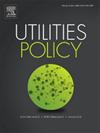Private ownership of water and wastewater systems: Assessing health impacts
IF 4.4
3区 经济学
Q3 ENERGY & FUELS
引用次数: 0
Abstract
This study examines the impact of private ownership of water and wastewater systems on disease reduction linked to sanitation in Brazil from 1998 to 2021. It updates Saiani and de Azevedo (2018), which analyzed the period 1995–2008, by incorporating over a decade of additional data, key policy changes such as the 2020 Sanitation Law, and employing the Callaway–Sant’Anna Staggered DID methodology to address heterogeneity in treatment effects. Our findings reveal mixed results: while some municipalities achieved reductions in morbidity rates, others showed no change or increases, underscoring the context-dependent nature of privatization outcomes. A notable example is the case of Tocantins, where transitioning from a hybrid private-state model to full private ownership led to a significant decrease in disease morbidity, particularly among the most affected age groups. These advancements provide a robust, updated perspective on the privatization debate, offering valuable implications for policy and practice.
水和废水系统的私有制:评估健康影响
本研究考察了1998年至2021年巴西水和废水系统私有制对减少与卫生有关的疾病的影响。它更新了Saiani和de Azevedo(2018)对1995-2008年期间的分析,纳入了十多年的额外数据、2020年《卫生法》等关键政策变化,并采用Callaway-Sant 'Anna交错DID方法来解决治疗效果的异质性。我们的研究结果显示了不同的结果:虽然一些城市的发病率有所下降,但其他城市的发病率没有变化或增加,这强调了私有化结果的环境依赖性。一个显著的例子是托坎廷斯,在那里,从公私混合模式过渡到完全私有制导致疾病发病率显著下降,特别是在受影响最严重的年龄组中。这些进展为私有化辩论提供了一个强有力的、最新的视角,为政策和实践提供了宝贵的启示。
本文章由计算机程序翻译,如有差异,请以英文原文为准。
求助全文
约1分钟内获得全文
求助全文
来源期刊

Utilities Policy
ENERGY & FUELS-ENVIRONMENTAL SCIENCES
CiteScore
6.80
自引率
10.00%
发文量
94
审稿时长
66 days
期刊介绍:
Utilities Policy is deliberately international, interdisciplinary, and intersectoral. Articles address utility trends and issues in both developed and developing economies. Authors and reviewers come from various disciplines, including economics, political science, sociology, law, finance, accounting, management, and engineering. Areas of focus include the utility and network industries providing essential electricity, natural gas, water and wastewater, solid waste, communications, broadband, postal, and public transportation services.
Utilities Policy invites submissions that apply various quantitative and qualitative methods. Contributions are welcome from both established and emerging scholars as well as accomplished practitioners. Interdisciplinary, comparative, and applied works are encouraged. Submissions to the journal should have a clear focus on governance, performance, and/or analysis of public utilities with an aim toward informing the policymaking process and providing recommendations as appropriate. Relevant topics and issues include but are not limited to industry structures and ownership, market design and dynamics, economic development, resource planning, system modeling, accounting and finance, infrastructure investment, supply and demand efficiency, strategic management and productivity, network operations and integration, supply chains, adaptation and flexibility, service-quality standards, benchmarking and metrics, benefit-cost analysis, behavior and incentives, pricing and demand response, economic and environmental regulation, regulatory performance and impact, restructuring and deregulation, and policy institutions.
 求助内容:
求助内容: 应助结果提醒方式:
应助结果提醒方式:


